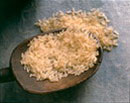 Rice, throughout history, has been one of man's most important foods. Today, this unique grain helps sustain two-thirds of the world's population, yet little is known about the origins of rice cultivation. Archeological evidence suggests rice has been feeding mankind for more than 5,000 years. The first documented account is found in a decree on rice planting authorized by a Chinese emperor about 2,800 BC. From China to ancient Greece , from Persia to the Nile Delta, rice migrated across the continents, eventually finding its way to the Western Hemisphere . Rice, throughout history, has been one of man's most important foods. Today, this unique grain helps sustain two-thirds of the world's population, yet little is known about the origins of rice cultivation. Archeological evidence suggests rice has been feeding mankind for more than 5,000 years. The first documented account is found in a decree on rice planting authorized by a Chinese emperor about 2,800 BC. From China to ancient Greece , from Persia to the Nile Delta, rice migrated across the continents, eventually finding its way to the Western Hemisphere .
Enterprising colonists were the first to cultivate rice in America . It began quite by accident when, in 1685, a storm-battered ship sailing from Madagascar limped into the Charles Towne harbor. To repay the kindness of the colonists for repairs to the ship, the ship's captain made a gift of a small quantity of "Golden Seede Rice" (named for its color) to a local planter.
The low-lying marsh lands bordered by fresh tidal water rivers of the Carolinas and Georgia proved to be ideal for rice production. The soils were rich, reasonably flat and highly fertile. They also were so soft a man could hardly stand on them, with twice a day tides pushing fresh river waters onto the flood plains, nothing else could be grown there.
By 1700, rice was established as a major crop for the colonists. That year 300 tons of American rice, referred to as "Carolina Golde Rice," was shipped to England . Colonists were producing more rice than there were ships to carry it.
By 1726, the Port of Charleston was exporting about 4,500 metric tons of "Carolina Golde," which later became the standard of high-quality rice throughout the world. When America gained independence 50 years later, rice had become one of her major agricultural businesses. Then came the War Between the States and an end to the plantation era. This, together with the ravages of hurricanes and competition from other crops, moved rice westward. The sprawling plantations of the Gulf Coast , parceled out to soldiers returning from the war, became a new home to rice crops. Still, high labor costs kept the industry from expanding. Not until mechanized farming methods came into use would the Gulf Coast rice industry become viable.
In 1884 , the Machine Age was beginning to affect every aspect of American life. It was the year an Iowa wheat farmer pointed out that the broad prairie land of southwestern Louisiana and southeastern Texas has solid soils which could hold up heavy equipment like the machines used for the production of wheat in Iowa . A revolution of mechanization followed, establishing what are today's major Southern rice growing states: Arkansas , Louisiana , Mississippi , Missouri , and Texas .
Meanwhile, the 1849 gold rush brought people from all nations to California . Among them were an estimated 40,000 Chinese, whose staple food was rice. To feed the immigrants, rice production became a necessity. Farmers in the Sacramento Valley found rice would adapt well to heavy clay soil conditions that were largely unsuited to other crops. By 1920, California was a major rice-producing state. More recently, farmers of Southern Florida began growing rice.
Technological improvements have evolved over the years to make American rice production the most efficient and advanced in the world. New mechanization and techniques have helped the American rice farmer reduce the costly time spent in the field to only seven man-hours per acre. Some Asian countries continue to require 300 man-hours per acre.
From its meager beginnings in South Carolina , rice has become a major U.S. agricultural product. Nearly 90 percent of the rice consumed in the United States is produced within its borders. Today, the United States is the world's most advanced, innovative rice producers. One of the largest exporters of rice in the world, the United States is respected worldwide for its abundant production of high-quality rice.
For full report, click here.
Click here to fill out the Online Request Form |